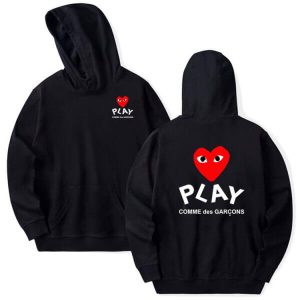The fashion world has always been a playground for artists, designers, and creatives to push the boundaries of what clothing can be. Comme des Garçons, the avant-garde fashion brand founded by Rei Kawakubo, is known for its ability to turn comme des garcon clothing into pieces of art. In its latest collection, Comme des Garçons has once again broken the mold by introducing wearable sculptures that challenge traditional notions of fashion. These sculptural garments transcend simple aesthetics, merging art, form, and fashion into a striking commentary on contemporary design.
An Exploration of Form and Structure
One of the most compelling aspects of this collection is how the designer plays with form and structure. Unlike conventional clothing, which is designed to fit the human body in a practical way, the garments in this collection are constructed in ways that distort, deconstruct, and reshape the body. They are not simply meant to be worn; they are meant to be experienced, both by the wearer and the observer.
The garments are often oversized and exaggerated, with dramatic silhouettes that challenge the norms of proportion and fit. The clothing appears as if it has been pulled from the world of sculpture, with sharp angles, unexpected volumes, and sculptural folds. These designs evoke a sense of transformation, as if the wearer is a living, breathing work of art. The garments become extensions of the body, rather than mere coverings.
Innovative Materials and Techniques
Comme des Garçons has long been known for its unconventional use of materials, and this collection is no exception. The garments are constructed using a variety of materials that are not typically associated with traditional fashion. From crinkled and manipulated fabrics to rigid, almost architectural materials, the collection is a testament to Kawakubo’s ability to rethink what fabric can do.
Many of the pieces feature intricate draping and folding techniques, which not only create an interesting visual impact but also contribute to the sculptural nature of the designs. Some garments appear as if they are in constant motion, with fabrics arranged in a way that suggests a dynamic, almost fluid shape. Others are more rigid, with materials that hold their form like pieces of modernist sculpture. This contrast between flexibility and rigidity adds an intriguing layer to the collection, making it feel as though each piece exists in a state of constant evolution.
An Artistic Statement
At its core, Comme des Garçons’ latest collection is not just about fashion; it is about making a bold artistic statement. Rei Kawakubo has always been a designer who challenges the status quo, and this collection is a continuation of that philosophy. The garments are not intended to be worn casually or for everyday purposes; instead, they are meant to provoke thought and spark conversation. They ask us to question the very nature of fashion, what it means to wear something, and how clothing can be a form of self-expression.
The collection also seems to question the idea of beauty. In many ways, these wearable sculptures are intentionally imperfect. They are not about flattering the body or adhering to conventional standards of beauty. Instead, they are about creating something new, something unique, and something that feels both strange and beautiful at the same time. The imperfections and distortions in the designs suggest that beauty is subjective and that fashion should not be confined to narrow ideals.
The Intersection of Fashion and Art
What sets Comme des Garçons apart from other designers is its ability to bridge the gap between fashion and art. While many fashion designers are content to create beautiful clothing, Kawakubo has always viewed fashion as a form of expression that is just as valid as any painting, sculpture, or installation in a gallery. In this collection, the garments are not just things to be worn; they are statements in and of themselves. They challenge our perceptions of beauty, form, and function, asking us to reconsider what fashion can be.
This blurring of lines between fashion and art is part of what makes Comme des Garçons so influential. The brand has never been afraid to take risks, to create designs that are not immediately understood or accepted. And while some may find the wearable sculptures in this latest collection difficult to comprehend, they represent the future of fashion—a future where clothing is not just about utility or appearance, but about creating something that transcends the ordinary.
The Legacy of Rei Kawakubo
As one of the most innovative and influential designers of our time, Rei Kawakubo’s legacy is firmly cemented in the world of fashion. Her ability CDG Long Sleeve to transform clothing into art has reshaped the fashion industry and influenced countless designers. With this latest collection, Kawakubo once again demonstrates her ability to challenge conventions and push the boundaries of what is possible in fashion.
For those who have followed Comme des Garçons over the years, the latest collection feels like another step in Kawakubo’s ongoing exploration of form, structure, and identity. It’s a reminder that fashion is not just about what we wear, but about how we choose to express ourselves and engage with the world around us. Comme des Garçons’ wearable sculptures are a testament to the power of fashion to provoke, to inspire, and to challenge the way we think about beauty and design.
Conclusion
Comme des Garçons’ latest collection is a masterclass in wearable sculpture. By blending the worlds of fashion and art, Rei Kawakubo has once again proven that fashion is more than just a way to dress—it is a form of self-expression, an art form in its own right. The collection’s sculptural garments offer a thought-provoking take on beauty, form, and function, while also challenging the conventions of what fashion can be. For those willing to look beyond traditional definitions of fashion, this collection offers a bold new vision for the future of design.

No Responses